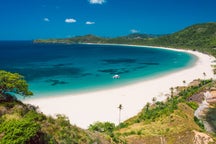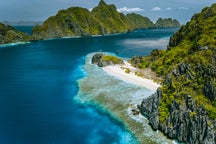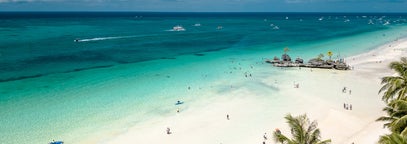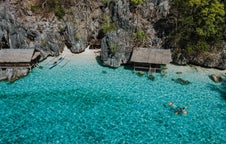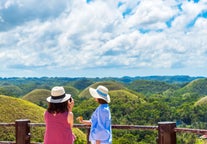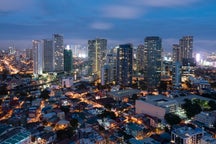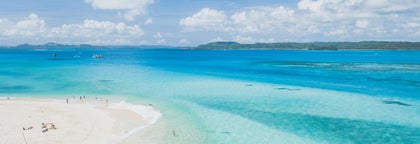Cebu

There is probably nowhere else as diverse, wondrous, and adventure-filled in the entire Philippines than the province of Cebu. From cultural and religious landmarks, scenic mountaintops and rugged terrains, world-class dive sites and idyllic islands, delectable local cuisine, to a dynamic mix of first-class cities and rustic towns, Cebu has it all. Add to these an award-winning international airport, and you enter into an all-in-one destination hailed as one of the best islands in Asia.
Before getting into the details of how jam-packed Cebu is as a travel destination, it is important to note that the name Cebu may refer to both the island province as a whole and Cebu City, the capital. The latter is a highly urbanized metropolis peppered with heritage sites, religious structures, modern skyscrapers, and expansive malls. The rest of Cebu is where you will find awe-inspiring natural wonders and striking man-made attractions.
Aside from its scenic wonders, Cebu is also considered a center of culture, a hub for creativity and craftsmanship, and a gastronomic capital, drawing in 2 million foreign tourists every year. Cebu also holds some of the busiest airports and seaports in the country, serving as a convenient jump-off point to other renowned destinations such as Boracay, Bohol, Siargao, Siquijor, and Palawan. Getting to these places from Cebu will just be a short and affordable plane or boat ride.
With unique activities in Cebu, such as swimming with million sardines or majestic thresher sharks, canyoneering through turquoise-colored rivers and waterfalls, or witnessing an annual festival of grand proportions, the province is truly a shining jewel in the entire Philippines with limitless possibilities for unforgettable adventures.
Best time to visit
Because Cebu is so diverse in terms of scenery and activities, it is important to plan which of the province’s many destinations you will be visiting and consider weather conditions, budget, and time. This way, you will know which is the best time of the year to travel to Cebu.
Cheapest time to visit Cebu
Like the rest of the Philippines, Cebu sees low visitor arrivals during the rainy months from July to October. Flight tickets and hotel prices will be at their lowest rates during these times. However, Cebu City is generally a great place to be all year round since it also has many indoor sights and activities that do not necessarily need bright, sunny days.
Weather in Cebu
Cebu enjoys both dry and wet seasons. December to May are considered warm and dry months with peak temperatures of up to 34°C during April, while June to November are the rainy months with temperatures dropping below 30°C .
Peak season in Cebu
Most of Cebu’s top attractions and activities are from the great outdoors, from diving, swimming, canyoneering, and trekking, and these are best experienced during the dry months of December until May, with high tourist arrivals during the summer months of March, April, and May.
Holidays such as Christmas, New Year, and Holy Week, which all fall under the dry months, are also peak travel seasons in Cebu.
Main festival/events in Cebu
One cannot simply talk about Cebu without mentioning one of the grandest and biggest celebrations in the country, the Sinulog Festival. Drawing in more than 200,000 local and foreign visitors over the past years, the Sinulog Festival is celebrated every third Sunday of January in honor of Santo Niño, or the Child Jesus, the patron saint of Cebu. The festival hosts colorful parades, massive street parties, and religious events.
When to avoid visiting Cebu
If you wish to maximize your time in Cebu and fully enjoy its many landscapes and islands, avoid visiting during the rainy months of July to September, which also sees typhoons coming in. Flights may be canceled, and island hopping trips and waterfall activities are deemed unsafe during this time.
If you’re also not into big crowds, you may want to visit after the Sinulog Festival as roads will be highly congested, streets will be crowded, and hotel prices are on a surge during this week-long festivity.
How to get to Cebu
Cebu is arguably the busiest tourism gateway in the Philippines, next to Manila. Local visitors may visit the province via air or sea travel, while foreign tourists may fly directly to Mactan-Cebu International Airport from certain international points of origin.
Connected to over 20 domestic destinations all over the Philippines, the Mactan-Cebu International Airport (CEB) serves as an easy and convenient entry point to visit Cebu City and the rest of the province. Major jump-off points include the Ninoy Aquino International Airport in Manila, Clark International Airport in Pampanga, Davao International Airport in Davao City, and the Laguindingan Airport in Cagayan de Oro City, and even smaller airports in Kalibo, Iloilo, and Puerto Princesa also have direct flights to Cebu. The airport is located in Mactan Island, about an hour away from Cebu City. There are also flights from Baguio to Cebu.
The airport also services international flights from over 20 destinations, including most countries in North and Southeast Asia. There are even long-haul flights from Los Angeles and Dubai going to Cebu.
Once in the airport, you have the option to ride a taxicab, board a bus, or hire a car rental to go to your accommodations or any drop-off points in many parts of Cebu City.
If you wish to reach Cebu by sea travel, there are many ferries and fast crafts coming from Manila, Dumaguete, Bohol, Iloilo, Leyte, Cagayan de Oro, and Butuan.
Safety in Cebu
Cebu City, being a bustling metropolis, may have higher incidents of theft or pickpocketing and other disturbances that are usually rampant in big cities. But if you find yourself in Cebu’s smaller towns and islands, you will not run into such problems that much.
Overall, Cebu is a safe destination to be in and travel around. Cebuanos, as people from Cebu are called, are also esteemed to be some of the friendliest and most hospitable people in the Philippines.
Getting around Cebu
The entire province of Cebu is a big island, with over 100 smaller islands and islets surrounding the main island. Visitors are encouraged to carefully plan their itinerary in Cebu to know which kind of transportation they would need to get around the city and to the other towns in the rest of Cebu.
When in Cebu City, the most popular mode of transportation are jeepneys. They have specific routes around the city (usually indicated as a combination of numbers and letters) so it is best to ask your hotel’s front desk or locals on which jeepney route you should take depending on the attraction or destination you wish to see and be dropped off. There are also tricycles around the city, usually taking you to smaller streets and inner neighborhoods. To avoid confusion, especially for Cebu City first-timers, it is recommended to hail a taxi.
If you wish or need to go from Cebu City to other cities or municipalities in Cebu province, you will need to ride a bus or mini-bus. Head to the Cebu North Bus Terminal in Subangdaku, Mandaue City if you are going to the northern towns of Cebu, which include Hagnaya, Kawit, Bogo, Carmen, Catmon, and Danao.
If you are headed to the towns of Santander, Oslob, Argao, Moalboal, and Carcar, you will need to take the bus or mini-buses from the Cebu South Bus Terminal in Sambag, Cebu City.
Food and Drinks
Cebu is one of the most exciting destinations in the country to go to for a unique and unforgettable food adventure. The province is almost synonymous with lechon, or roasted whole pig seasoned with herbs and spices, which is unofficially regarded as the national dish of the country. Famous world explorer Anthony Bourdain once said that lechon is “the best pig ever” when he visited the Philippines. You can try the province's famous lechon in local restaurants in Cebu.
Cebu, surrounded by bountiful waters, is also famous for having fresh seafood. Choose from the province’s wide selection of fish, shellfish, and crabs, best enjoyed through the iconic SuTuKil experience, a combination of 3 Visayan words, "sugba," "tula," and "kilaw," which means grilled, broth or soup, and to eat raw (similar to ceviche), respectively.
Tipping
As with the rest of the Philippines, tipping is not mandatory, but local service staff will greatly appreciate gratuities.
Best restaurants
Some of Cebu’s most iconic restaurants are concentrated in Cebu City, which range from budget, mid-range, to upscale establishments serving Cebu’s finest dishes such as lechon, grilled meats, and seafood. Other towns in Cebu would have their own local unique delicacies, which include saltwater eels and pig’s brain.
Nightlife
With a thriving night scene, Cebu City is the best place to be in the entire province if you wish to go drinking and dancing. You will have many options around the city, from small beer pubs, cocktail bars, and massive clubs.
Outside Cebu City, the coastal town of Moalboal also has a great nightlife with local bars and restaurants serving cold beers and upbeat tunes for visitors, especially international tourists, to enjoy.
Drinking in public has been widely prohibited around the country, but is mostly enforced in bigger cities. To avoid any problem, it is best to drink and smoke cigarettes inside restaurants, bars, or your accommodations, according to their own regulations.
Best Neighborhoods to Stay in Cebu
For Sightseeing
Stay in towns outside of Cebu City if you wish to have closer access to the province’s many majestic natural attractions. North of Cebu City is where you can find the breathtaking beaches of Bantayan Island, go cliff diving in Camotes Island, and dive with thresher sharks in Malapascua Island.
Head South of Cebu City if you wish to experience the famous sardine run in Moalboal, where you can swim with a million sardines just a few meters away from the shore, or go for an adrenaline-pumping canyoneering activity from the town of Alegria all the way to Kawasan Falls.
For Shopping
Stay in the bustling Cebu City to shop until you drop. It is home to massive lifestyle malls such as SM Seaside City (the third largest shopping mall in the entire country), Ayala Center Cebu, SM Cebu, and Robinsons Galleria. The city is also peppered with numerous boutiques, specialty shops, and souvenir shops in almost every district or corner.
For Entertainment & Arts
General Maxilom Avenue, popularly known as Mango Avenue, in Cebu City is where you should stay if you want easy access to historical and cultural landmarks in Cebu, such as Fort Santiago, Casa Gorordo, and the Magellan’s Cross. It is also right beside Fuente Osmeña Circle, regarded as the center of the entire Cebu Province, where all the local action happens.
For Nightlife
Cebu IT Park in Lahug is a lifestyle and business enclave at the heart of Cebu City. It is home to several corporate buildings, residential condominiums, and complexes with numerous restaurants, cafes, and bars, making it easy to go from one spot to another without having to commute.
Mango Avenue is also lined with many dining and drinking establishments.


